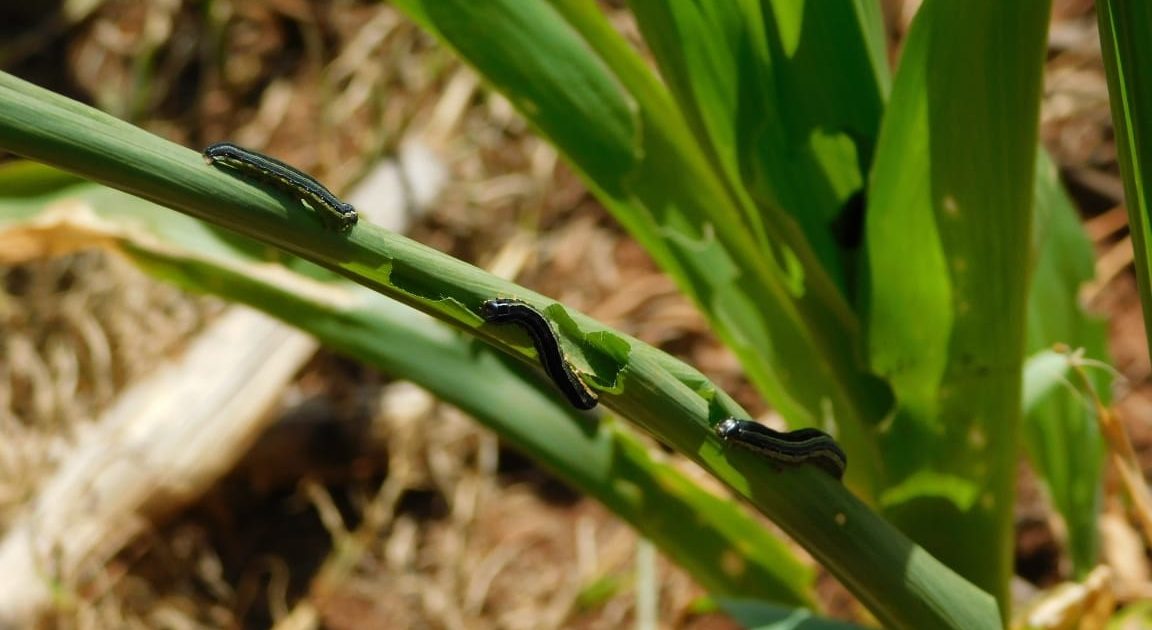Swarms of African armyworms have invaded farms in parts of Nakuru County, threatening starvation for humans and livestock.
County Agriculture Chief Officer Mr. Kibet Maina indicated the destructive worms had infested over 10,000 hectares of land in Rongai and Subukia Sub-counties by Sunday.
While stating that the African army worm was more destructive than the fall armyworm Mr. Maina stated that the county administration had dispatched certified spray service providers (SSPs) to help farmers in affected regions in managing and eradicating the pest.
“The County government lays a lot of emphasis on food security and nutrition and the creation of wealth through agribusiness. We are addressing the African armyworms infestation with prescribed pesticides and other cultural methods,” said the Chief Officer.
Mr. Kibet revealed that the migratory pest was first spotted at Ndatho Village in Waseges ward within Subukia Sub-County feeding on germinating crops and other vegetation.
“The African armyworm is different from the fall armyworm. The fall armyworm normally eats young green maize alone. The African armyworms are so deadly because they feed on the entire crop and are active both during the day and in the night. But we are in control and have taken the necessary steps to stop them from spreading any further,” Mr. Kibet explained
The African armyworm mainly attacks cereals, grasses, barley, pearl millet, African millet, maize, oat, rice, sorghum, sugarcane, wheat and pasture grasses.
Mr. Kibet stated that the devolved unit was offering logistics to its agricultural field extension officers to sensitize farmers on how to identify the pests and spray with the right chemicals to contain their spread.
The Chief Officer said the SSPs further trained small scale farmers in the affected areas on proper usage of the pesticides adding that among responses lined up are training of all stakeholders involved in control operations, dissemination of technical information, public awareness and enhanced data collection from the field to a centralized data centre at the County.
“The training by SSPs included how to maintain personal safety for the spray providers, other humans, livestock, the environment and other forms of life, as well as responsible use of pesticides for maximum effectiveness,” he added.
Mr. Kibet added that the Department of Agriculture, Livestock and Fisheries had put in place a framework for collaboration and monitoring of migratory and invasive pests adding that it was liaising with various agencies to empower small-scale farmers through training to fight the pest as well as create buffer zones to curb the spread of the armyworms to other areas.
The current outbreak comes at a critical time when farmers are in the devolved unit are in the main maize planting season.
A report compiled by the State Department of Crops Development and Research indicates that 500,000 acres of land in Kenya have been affected by the destructive pests.
According to the Principal Secretary in the State Department for Crop Development and Agricultural Research Dr Francis Owino most farmers in 33 worst hit counties started seeing the pests as early as February.
Mr. Kibet said the African armyworm was one of the three plant pests in Kenya that pose a great threat to food and nutrition security, alongside desert locusts and quelea birds.
He added: “while the County Government is committed to supporting the national government’s initiative to install and revive the African army worm warning system and monitoring we will remain at the forefront in reporting, overseeing execution of control operations and community awareness.”
The African armyworm is a transnational migratory pest of economic significance due to its high reproductive capacity, rapid development, high mobility and intensive feeding habit.
The African armyworm caterpillars are reported to have previously destroyed thousands of hectares of food crops in Malawi, Zimbabwe, Ghana and Zambia.
They found their way in Kenya from Ghana and South Africa due to climate change. The African armyworm is mainly found in the grasslands of Africa and Asia. Within Africa, it is mostly seen in Tanzania, Kenya, Uganda, Ethiopia, Somalia, Malawi, Zimbabwe, Zambia, and South Africa.
Failure to contain the pests or delays in tackling them can potentially lead to 100 percent crop and pasture loss.
A report by FAO last year stated that climate change-induced pest dispersal poses a threat to food security.
The report noted that pests such as the African armyworm are often impossible to eradicate once they have established themselves in a new territory, and managing them is time-consuming and expensive.
By Anne Mwale and Elizabeth Simiyu





